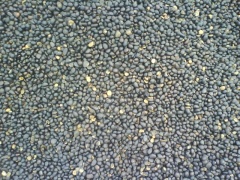Palm Kernels
| Infobox on Palm Kernels | |
|---|---|
| Example of Palm Kernels |  |
| Facts | |
| Origin | - |
| Stowage factor (in m3/t) |
|
| Humidity / moisture | - |
| Ventilation | See Seedcake |
| Risk factors | See text |
Palm Kernels
Description
The Palm kernel is the edible seed of the oil palm tree. The fruit yields two distinct oils—Palm Oil derived from the outer parts of the fruit, and palm kernel oil derived from the kernel. The kernels yield an oil (approx.. 45-50%) which is much in demand for the manufacture of cattle food, soaps, etc.
The pulp left after oil is rendered from the kernel is formed into "palm kernel cake", used either as high-protein feed for dairy cattle or burned in boilers to generate electricity for Palm Oil mills and surrounding villages.
Palm kernel cake is most commonly produced by economical screw press, less frequently via a more expensive solvent processes.
Application
Uses: Palm kernel cake
Palm kernel cake is a high fibre, medium-grade protein feed best suited to ruminants] Among other similar feedstocks palm kernel cake is ranked a little higher than copra cake and cocoa pod husk, but lower than fish meal and groundnut cake, especially in its protein value.
Composed of 16% fiber, palm kernel cake also has a high phosphorus to calcium ratio. and contains such essential elements such as magnesium, iron and zinc. The typical ration formulated for the feeding of dairy cattle consists of palm kernel cake (50%), molasses (5%), grass/hay (42%), limestone (1.5%), mineral premix (1%) and salt (0.5%) and trace element/vitamin premix.
Shipment / Storage / Risk factors
Shipped in bags or in bulk. Used for the extraction of oil and the manufacture of cattle feed.
According to the degree of freshness, this commodity loses a variable percentage of oil, which can be noted by the dark colour and greasy state of the sacks (if packed).
Stowage near boilers or in a damp hold is liable to provoke mould, usually a white film which can be brushed away. Palm kernels are much harder and more resistant to damage than groundnuts, and consequently damage is much less frequent and more difficult to detect. If wetted for any length of time, kernels will swell and soften. Signs of damage are similar to those in groundnuts; in particular a characteristic sour smell indicates damage. Free fatty acid does not tend to rise so quickly but accompanying oxidation tends to do more damage to the quality of the refined oil.
The greater the amount of water and the longer the time of soaking, the greater the damage. Palm kernels are liable to heat and sweat.
See also Oil Seeds.
Reference is made to the relevant IMO regulations on hazardous cargo Seedcake











